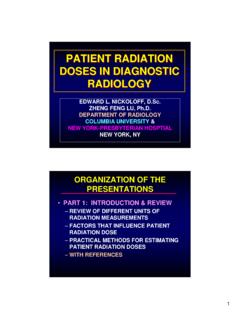Transcription of The Surgical Management of Pituitary tumours Indications ...
1 The Surgical Management of Pituitary tumoursIndications, techniques, results and complicationsMr Nigel MendozaConsultant NeurosurgeonCharing Cross HospitalPituitary surgery : Anatomical considerationsPituitary gland Position Pituitary fossa Mass: 5 gms Size 7mm (Ht) 9mm (AP) 11mm (transverse) tumours of the Pituitary fossa Adenohypophyseal tumours Pituitary adenoma Non - functioning Functioning Primary sellar tumours Craniopharyngioma Chordoma Teratoma Meningioma Angioma Fibroma Glioma Harmatoma Germinoma Paraganglioma Sarcoma Ganglioglioma Metastasis Carcinoma Sarcoma Lymphoma Congenital Rathkes pouch cystClinical presentation : Mass effect Visual disturbances Visual field defect usually very insidious and slowly progressive Diplopia Visual acuity Hydrocephalus Gait disturbance Headache Cranial nerve palsies Raised intracranial pressureClinical presentation : Hypersecretion Prolactin Galactorrhoea , amennorrhoea, osteoporosis Acromegaly, organomegaly, , CTS ACTH Cushing s disease, Diabetes mellitus, osteoporosis, obesity, hypertension TSH Hyperthyroidism, cardiac dysrythmia, heat intoleranceClinical presentation : Pituitary apoplexy Acute presentation secondary to tumour haemorrhagic necrosis Headache Vomiting Blindness Ocular paresis Altered level of consciousnessImaging of Pituitary tumours X -Ray Sellar expansion MRI Tumour volume Suprasellar extension Chiasmal compression Tumour shape cottage loaf Lateral extension into cavernous sinus Signal characteristics Aneurysm, meningioma CT Sphenoid sinus anatomy IPSS Lateralises an adenoma in about 70 - 80% of casesGrading system for Pitutary tumour Hardy : based on plain X ray of sellarappearance Normal Grade 1 : Focal bulging of sellar turcica Grade 2 : Intact sellar.
2 Diffuse bulging Grade 3 : Focal erosion and destruction of sellar floor Grade 4 : Diffuse destruction of sellar floor Fahlbusch :based on CT / MRI of tumour size Macroadenoma> 10 mm Microadenoma< 10 mmModalities of treatment Medical Dopamine agonist Octreotide ( ? Pre op ) Replacement therapy Surgery Transphenoidal Transcranial Radiotherapy Conventional fractionated external beam Stereotactic gamma knife radiosurgery Interstitial brachytherapy/ photodynamic therapyIndications for surgery Tumour with mass effect( Macroadenoma : > 1cm ) Chiasmal compression and objective visual field defect Raised intracranial pressure Pituitary dependant Cushing s disease GH secreting tumour Prolactinoma Failure of medical of treatment Intolerance of medical Management Pt preference TSHoma ThyrotoxicosisRecent innovations Intraoperative stereotactic neuronavigationFrameless stereotaxy for TS surgery. Elias W, Chadduck J, Alden T, Laws E.
3 Neurosurgery 45: 271 - 277, 1999 Endoscopic assisted transphenoidal surgeryTransnasal - transphenoidal endoscopicsurgery of the Pituitary gland . Carrau R, Jho H, Ko Y. Laryngoscope 106 : 914 - 918, 1996 Stereotactic radiosurgery Technical improvements Extended skull base approaches Reconstruction of skull base Intraoperative magnetic resonance imagingTranssphenoidal approach to Pituitary fossaApproaches to Pituitary fossa lesions Transsphenoidal Transnasal paraseptal Extended Sublabial transseptal Endonasal rhinoseptal Transethmoid Transcranial Subfrontal PterionalTSPH : Set up and instrumentsTransnasal paraseptal approachNon - functioning Pituitary adenoma49 yr old male with panhypopitiuitarism, blindness, and hemiparesisNon - functioning Pituitary macroadenomaPeri- and post op imagingRightLeftPre - opLeftRightPost - opLP 35yr male with acute headache and visual lossPituitary apoplexyRathkes Cleft 47 yr male progressive loss of visionEndoscopic endonasal transphenoidal surgeryAdvantagesImproved illuminationImproved vision 0o / 30o rigid endoscopeLess nasal complicationsRevision surgery / normal Pituitary fossa?
4 Improved tumour resection?? Improved outcomeDisadvantagesLearning curve2 D view cf binocular microscope viewInstrumentationPubMed : Endoscopic transphenoidal Pituitary surgery : 120 publications 1978 - 2006 Endoscopic endonasal assisted 38 male Cushings and MicroprolactinomaEndoscopic endonasal transphenoidal H, 87: 44-51 ,1997 Surgical complications associated with the endoscopic transsphenoidalapproach. Cappabianca et al. 97:293-298,2002 Postoperative Management IVI down at 24 hrs Packs out at 48 hours Continue replacement therapy Visual fields post op Home at day 2 post op Endocrine day case admission at 3-6 / 52 OP clinic at 3 / 12 with post op MRI Cases discussed in monthly MDTM onitoring and follow-up : Multidisciplinary team Hormonal status- Endocrinologist Visual fields- Orthoptist Monitor tumour recurrence- Radiologist Observation- Neurosurgeon Blood tests- Biochemist Irradiation- RadiotherapistTumours of the Sellar region : Charing CrossSurgical series : 1995 - 20061204543928020406080100120140NF AdenomaACTHGHP rolactinOtherCranial Base Surgery.
5 Pituitary Tumours1995 - 2006 245 operative procedures 120 Chromophobeadenoma 42 GH 45 ACTHs 9 Prolactinomas 28 other Rathke cleft cyst7 Craniopharyngioma4 Metastasis3 Teratoma2 Germinoma1 Chordoma1 TSHoma1 MEN ( ACTH/Pr )1 Glioma1 Pituicytoma1 Oncocytoma1 Xanthogranuloma1 Abscess1 Meningioma1 Chronic Lymphocytic Leukaemia 1 CSF Fistula1 RESULTSR esults : Visual recoverySeries Nos Recovery Symon 101 57% full, 37%partial Cohen 100 74% fields, 70% acuity Findlay 34 85% improved Laws 62 full 69% partial Powell 67 34% full 43% partial Mendoza 62 85% improved results : AcromegalySeries Nos % Cure Macro Micro Hardy 90 79 84 77 Laws 140 62 Teasdale 56 46 Landholt 169 70 76 64 Fahlbusch 227 57 81 65 Mendoza 27 50 80 results .
6 Cushings diseaseSeries Nos % Cure HypophysectomyTindall 56 9 Arnott 28 75 Mamplan 221 76 25 Fahlbusch 101 74 Cohen 8 50 2ndprocedureMendoza 45 80 Fully endoscopic endonasal vs transseptal transphenoidalpituitary surgeryKeby MS, Eby JB, Shahinian HK. Minim Invasive Neurosurg. 2005; 48: 348-54300 pts from 1998 2004 EETSS compared to historical series Av LOS : days54% Non functioning , 46 % hormonally activeMean f/u complications Nasal deformity Dry nose / anosmia Nasal perforation Visual loss Disturbance of Pituitary function Hypopituitarism Diabetes insipidus CSF rhinorrhoea Meningitis Haemorrhage Tumour cavity ICA Cavernous Pit.
7 Of into residual artery perforationComplications of transphenoidal surgery : results of anational survey. Ciric et al. Neurosurgery 40:225-237; 1997 Complications 5 transient CSF leaks 1 meningitis 1 hydrocephalus 1 ICA injury 1 post op intrasellar haematoma 3 deaths 1 PE 1 aneurysmal SAH 1moribund on admissionSummary Transphenoidal Pituitary surgery is safe and effective Treatment options are best considered in a multidisciplinary setting Neurosurgical units should have a subspecialist surgeon Recent innovations have not yet demonstrated improved outcomeThank you
